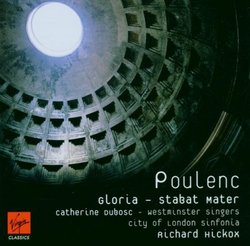| All Artists: Francis Poulenc, Richard Hickox, City of London Sinfonia, Catherine Dubosc Title: Poulenc: Stabat Mater/Gloria - Catherine Dubosc, Richard Hickox, Members Wishing: 0 Total Copies: 0 Label: Virgin Classics Original Release Date: 1/1/2006 Re-Release Date: 9/12/2006 Genre: Classical Styles: Opera & Classical Vocal, Symphonies Number of Discs: 1 SwapaCD Credits: 1 UPC: 094636329420 |
Search - Francis Poulenc, Richard Hickox, City of London Sinfonia :: Poulenc: Stabat Mater/Gloria - Catherine Dubosc, Richard Hickox,
 | Francis Poulenc, Richard Hickox, City of London Sinfonia Poulenc: Stabat Mater/Gloria - Catherine Dubosc, Richard Hickox, Genre: Classical
|
Larger Image |
CD DetailsSimilar CDs
|
CD ReviewsPoulenc's Choral Masterpieces M. De Sapio | Alexandria, VA | 08/31/2007 (5 out of 5 stars) "Francis Poulenc's sacred choral music is saturated in "Catholic worldliness", a state of mind where there is no real division between sacred and profane. Here, rather than being whisked away to a rarefied heavenly never-never land, the listener lives exuberantly in the "world" with all its earthiness. I believe this is the quality which some critics of Poulenc's time mistook for vulgarity when they heard the roguish yet strangely consistent mixture of asceticism and perfumed sweetness, austerity and debonair wit that make up the woof and warp of his music.
Poulenc's two big chorus-and-orchestra works from the 1950's represent the apex of his choral output. The exuberant GLORIA (1959) seems to sum up the essence of Poulenc - bright, jewel-like ideas expressed with crystaline clarity, simplicity, and directness. For me, the ideal recording of this piece is the one on Deutsche Grammophon with Seiji Ozawa, which dances with vitality and color. Hickox and his forces do a fine enough job here, but they don't take fire the way the Osawa version does; the lack of a bright acoustic doesn't help. STABAT MATER (1950) builds a compelling dramatic structure out of a series of miniature "altarpieces" which run the expressive gamut from stoic monumentality to childlike faith. Poulenc's chaste "white" style, deeply influenced by neoclassical Stravinsky, is at its most powerful here. The orchestra and chorus are superb, shaping the piece forcefully in terms of pacing and dynamics and creating a dramatic, emotional experience. Soprano Catherine Dubosc (who can be heard singing the role of Blanche in Poulenc's opera DIALOGUES DES CARMELITES on EMI) floats her ethereal solos in both the GLORIA and the STABAT with pure, white tone. Hers is a somewhat unconventional voice, with a quality of human frailty. LITANIES A LA VIERGE NOIRE ("Litanies to the Black Virgin"), an intense supplicatory prayer for women's chorus, is a seminal work in Poulenc's output as it marks his return to the Catholic faith around 1935. There is something experimental, almost avant-garde about this piece, what with its blocks of sound and dramatic pauses. The version with strings and percussion accompaniment presented here (there is also a version with organ accompaniment) is austere, mysterious, and moving. All in all, this is a worthy collection of Poulenc choral masterpieces." |

 Track Listings (19) - Disc #1
Track Listings (19) - Disc #1


